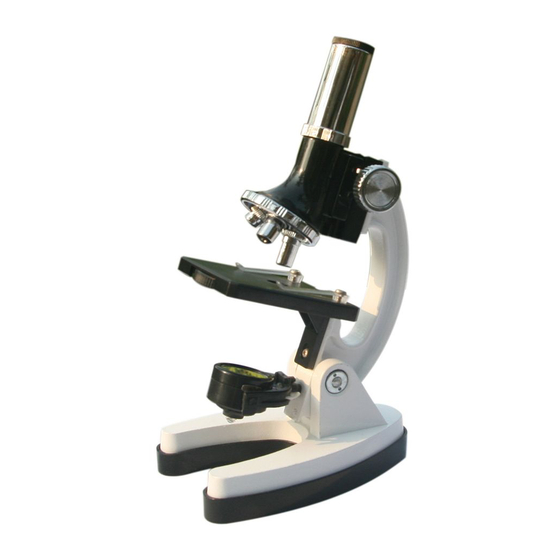cassini C-900M Instructions For The Use - Page 2
Browse online or download pdf Instructions For The Use for Microscope cassini C-900M. cassini C-900M 4 pages. 300x/600x/900x 98pc. microscope kit

W
M
ELCOME TO THE
ICROSCOPIC
We take great pleasure in introducing you to the world of the microscope. Your new
microscope is an instrument with lenses for making very small objects appear much
larger so they can be studied. There are millions of tiny living plants and animals that
can be easily seen with your microscope.
In today's technological world every science from the most fundamental biology to
the highly skilled field of astro-physiology use microscopes. Microscopes are used by
geologists for studying rocks and minerals, archaeologists who study very old items,
police departments who can study very small pieces of evidence, and even by as-
tronomers when they study fallen meteorites. Your microscope will let you see the
basic building blocks of life on Earth.
P
Y
M
:
ARTS OF
OUR
ICROSCOPE
Eyepiece
Revolving turret
Objective lens
Stage
Mirror
Illuminator lamp
(reverse side of
the mirror)
W
ORLD
Body tube
Focusing knob
(battery case)
2
You should replace the water with clean salt water every three or four days. Use a
magnifying glass to study the brine shrimp. Start with the dried eggs,
then study an egg that has been in the salt water for a few hours. You can then
study a freshly-hatched larva, and finally a mature brine shrimp.
You can carefully place a wet egg, larva, or adult brine shrimp on a blank slide for
study under low power on your microscope.
If you have brine shrimp remaining in your first container, and you have fish in a bowl
or aquarium, you can feed the shrimp to your fish. YOU MUST PLACE THE BRINE
SHRIMP IN FRESH WATER BEFORE YOU PLACE THEM IN A FISH TANK AS
FOOD. THIS IS BECAUSE TOO MUCH SALT CAN INJURE OR KILL MANY FISH
TYPES.
M
H
ORE
ELPFUL
1)
Always use the lowest magnification to begin a sample study. Higher
magnifications may not be better, as they are usually less bright.
2)
Look through the microscope with both eyes open. This may seem
awkward at first, but will soon feel natural. You will find that keeping
both eyes open is less stressful.
3)
Keep your work area clean and organized.
4)
Wash your hands before and after each session.
FAQ
– F
Arm
S
What can I see with my microscope?
You can see thousands of things that are difficult or impossible to see with
Clip
your eyes. You can see tiny plants and animals. You can observe plant and
animal cells. You can see the differences between different plants, different
papers, different fibers and hairs from different people. You can study crys-
tals, rocks, and minerals. The uses for your microscope are practically end-
less.
Base
What is meant by power?
Power is a measure of the seeing ability of your microscope. It is really a
short way of saying "magnifying power." Your microscope has three powers. They
are 300X (pronounced "300 times"), 600X, and 1,200X. This means that your micro-
scope can magnify the view of a sample so that it appears 300 times, 600 times, or
1,200 times larger than the way you see it with your eyes alone.
I look through my microscope and all I see is darkness. Why?
This could be because the mirror is not positioned properly to aim light up into your
microscope. Or maybe the sample you are looking at is too thick so that the light can-
not shine through it.
H
INTS
A
Q
REQUENTLY
SKED
UESTIONS
7
